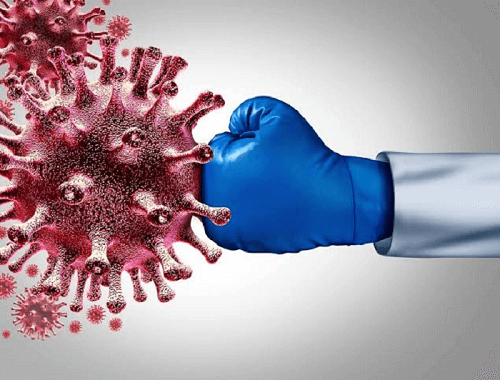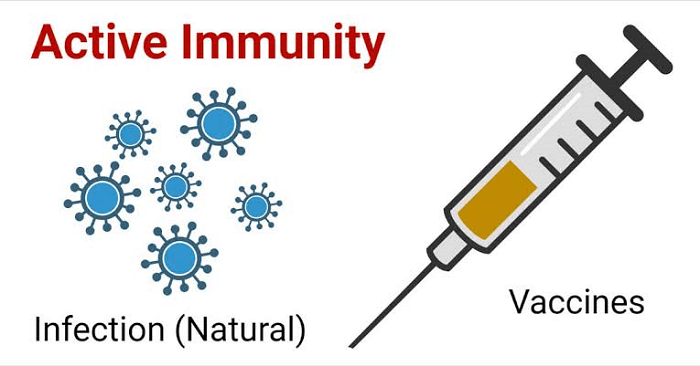Difference between Active and Passive ImmunityImmunityImmunity is the body's capacity to defend itself against toxic substances or infectious agents like germs and viruses. There are two types of immunity: active immunity and passive immunity. In general, the immune system is essential for defending the body against illness and infection. It can be strengthened by leading a healthy lifestyle that includes a balanced diet, frequent exercise, and enough sleep. It is continually evolving and altering in response to new threats. 
How to Boost Immune System:
It is crucial to remember that no one component can fully guarantee immunity to all forms of infection or disease. Adopting a healthy lifestyle that includes a balanced diet, frequent exercise, and good hygiene habits is the greatest method to strengthen the immune system. Active Immunity
Active immunity refers to the process by which the immune system of the body learns to identify and protect against certain pathogens, such as viruses or bacteria. Normally, the immune system of the body will produce this kind of immunity in reaction to exposure to a pathogen, or it will do so on purpose by administering a vaccine that contains a pathogen that has been killed or rendered inert. The body's immune system is made up of a complex network of cells, tissues, and organs that collaborate/work together to fight infection. When the body is exposed to a pathogen, the immune system mounts a response by producing antibodies, which are proteins that precisely detect and bind to the pathogen. The immune response is the term used to describe this process of producing antibodies. Types of Active immunity:There are two main types of active immunity: natural and artificial. 1. Natural Active Immunity: Natural exposure to a disease-causing agent, such as a virus or bacteria, is one way to develop natural active immunity. An individual's immune system mounts an immunological response to get rid of the virus after exposure because it detects it as being foreign. Antibodies, which are proteins that particularly detect and bind to the pathogen, are frequently produced during this process. White blood cells made by the immune system, such as T cells and B cells, aid in the pathogen's elimination and stop it from doing additional damage. Through this process, the immune system is prepared to identify and combat the virus if it is subsequently met. The disease is often long-lastingly protected by natural active immunity. For instance, if someone gets chickenpox and recovers from it, they probably have lifelong immunity to the illness and won't acquire it again. Natural active immunity can offer a certain level of protection, but it is not always sufficient. As a result, it is conceivable for a person to be re-exposed to the same pathogen and get the same illness. 2. Artificial Active Immunity: A form of immunity known as artificial active immunity is acquired when a disease-causing substance is consciously introduced into the body, such as during vaccination. A small quantity of a pathogen, or a pathogen that has been changed, is present in vaccines to trigger the immune system's production of antibodies and other immune cells that can attach to and recognize the pathogen. This technique is comparable to how natural active immunity is developed, however, vaccination rather than unavoidable exposure to the pathogen is used to intentionally induce it. Artificial active immunity frequently offers enduring defines against disease, similar to natural active immunity. Vaccines can offer protection that lasts about as long as acquired immunity since they are made to mimic the immune response to a virus. Similar to natural active immunity, artificial active immunity typically provides long-lasting protection against disease. Because vaccines are created to replicate the immune response to a virus, they can provide protection that lasts roughly as long as acquired immunity. Despite having had a vaccination, a person still has a chance of contracting the disease if they are exposed to it since the level of protection provided by artificial active immunity may vary and not always be complete. Artificial active immunity is a key public health measure to halt the spread of infectious diseases and protect people and communities from their harmful effects. In great part because of vaccination, which is also a key strategy for slowing the spread of other infectious diseases, smallpox and polio have been eradicated. Active immunity has the potential to continue for a very long time, even for a lifetime. Passive immunity, which is a transitory immunity that is passed from one person to another, usually through the exchange of antibodies, is normally less effective at defending against illnesses. Active immunity occurs when the body's immune system produces antibodies to fight against a specific infection or toxin. Some Notable Points about Active Immunity
Vaccines:Biological products called vaccines aid in preventing infectious diseases. They function by delivering a tiny, non-lethal particle of a pathogen (such as a virus or bacteria) into the body. As a result, the immune system is prompted to develop antibodies that aid in preventing further infections of the same diseases. Measles, polio, and influenza are just a few of the infectious diseases for which vaccines have been created. Vaccines are a crucial weapon in the fight against infectious diseases and are used frequently to do so. They have been essential in the suppression of numerous once-common diseases, including smallpox. There are several distinct kinds of vaccinations, including recombinant, inactivated, subunit, and live attenuated vaccines. Each type has a unique mechanism of action and is employed to guard against particular diseases. To safeguard yourself and others from diseases that can be serious or even fatal, it is crucial to get vaccinated. Vaccines have been rigorously evaluated before being made widely available, and they are typically quite safe and effective.
Immunity is the capacity of a person or a population to fend off or resist infectious disease. It can be either artificial immunity, which is gained through the administration of vaccines or immunoglobulins, or natural immunity, which is the immunity that a person is born with or develops in response to diseases or vaccines. Innate immunity and adaptive immunity are the two main categories of immunity. The initial line of protection against pathogens is innate immunity, which is present from birth. It comprises chemical barriers like enzymes and secretions as well as physical barriers like skin and mucous membranes. As opposed to immunisation, which is gained through exposure to a disease. While adaptive immunity also known as acquired immunity is the third line of defence against invading pathogens in the immune system. It is a specific type of immunity that develops and responds to exposure to a pathogen or immunogen and is characterised by the production of antibodies and the activation of immune cells called t cells. Passive ImmunityThe term "passive immunity" refers to the immunity that is passed from one person to another, frequently through the exchange of antibodies. The brief protection against infectious diseases offered by passive immunity normally lasts between a few weeks and a few months. Several methods can be used to develop passive immunity Passive immunity is not as long-lasting as active immunity, which is immunity that is produced by the individual's immune system in response to an infection or vaccine. Passive immunity can provide protection against certain infections in the short term, but it does not stimulate the individual's immune system to produce antibodies, so it does not provide long-term immunity. Examples of Passive Immunity:
Types of Passive ImmunityThere are two main types of passive immunity: Natural and Artificial.
When is Passive Immunity Helpful?
How to Produce Passive Immunity?
Difference between Active Immunity and Passive Immunity
Next TopicDifference between
|
 For Videos Join Our Youtube Channel: Join Now
For Videos Join Our Youtube Channel: Join Now
Feedback
- Send your Feedback to [email protected]
Help Others, Please Share










